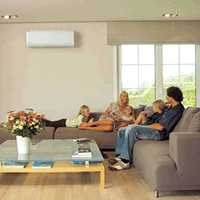
Single-Zone or Multi-Zone
Choosing Between Single-Zone & Multi-Zone Systems
Choosing between a single-zone and a multi-zone mini split system will depend upon your intended application.
If you wish to provide air conditioning or heating for all areas of your home, a multi-zone system will best serve your needs. However, if your goal is to provide air conditioning or heating for just one under-served area of your home, you only need a single-zone mini split system.
Below, we help you understand the differences between single-zone and multi-zone, as well as offer scenarios for each to aid in your decision.
Single-Zone Scenarios

If you have central air or another form of air conditioning already in place, but there's a new addition or another area of your home that's under-served, you could add a single-zone mini split system to cool just that area.
A single-zone mini split is also a good way to condition the air in your garage or workshop, providing more efficient cooling and heating than a window unit. And with a mini split, you'll still maintain use of any windows you have.
Another reason you may want to choose a single-zone system is if you have a very small home, such as a cabin with only two or three rooms. The single unit may serve to cool the entire home if it's small enough, however, you'll need to have good airflow to evenly distribute the air. Fans will work fine in circulating the air.
Operation
Installation is another factor to consider. Single-zone systems consist of an outdoor unit and a single indoor unit, one line set, one cable, and one drain line. Once the outside condenser and indoor unit are mounted, the refrigerant lines need to be installed.
Multi-Zone Comfort

For example, you can set one bedroom to 68 degrees and another to 72 for different sleeping temperature preferences. You can also turn select units off in rooms you're not using. If you have a guest room with a mini split unit, you can leave it turned off when no one is staying over.
This allows you to be even more efficient with your energy spending, since you can adjust the temperature or turn certain zones off, unlike with traditional forced-air systems that cool your entire home regardless of which spaces you're actually using.
Unlike traditional systems, which only accurately control the temperature in the room with the thermostat, mini splits will control the temperature accurately in each room that has a unit.
A perfect example of why you'd want to set separate temperatures in different zones is your bedroom. Many people prefer a cooler temperature when they're going to sleep than they do when they're awake and no longer under the covers. Keeping your bedroom temperature set a few degrees lower than your family room will help you customize your comfort.
Operation
The outdoor unit will run the refrigerant to the various indoor units to cool the air being blown through them. Some systems will require a branch box to split up the refrigerant and send it to the various different indoor units. If you're planning to install ceiling cassette units or concealed duct units, they may require more invasive installation methods, taking more time and possibly costing more in labor.
However, don't let any of this discourage you. Just remember the efficiency and savings you'll get in return for installing a mini split system in your home.
